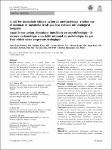Item Infomation
Full metadata record
| DC Field | Value | Language |
|---|---|---|
| dc.contributor.author | Marie-Luise, Rübsam MD | - |
| dc.contributor.author | Philippe, Kruse MD | - |
| dc.contributor.author | Yvonne, Dietzler MD | - |
| dc.date.accessioned | 2023-03-21T08:28:12Z | - |
| dc.date.available | 2023-03-21T08:28:12Z | - |
| dc.date.issued | 2023 | - |
| dc.identifier.uri | https://link.springer.com/article/10.1007/s12630-022-02393-z | - |
| dc.identifier.uri | https://dlib.phenikaa-uni.edu.vn/handle/PNK/7029 | - |
| dc.description | CC BY | vi |
| dc.description.abstract | Climate change is a global threat, and inhalational anesthetics contribute to global warming by altering the photophysical properties of the atmosphere. On a global perspective, there is a fundamental need to reduce perioperative morbidity and mortality and to provide safe anesthesia. Thus, inhalational anesthetics will remain a significant source of emissions in the foreseeable future. It is, therefore, necessary to develop and implement strategies to minimize the consumption of inhalational anesthetics to reduce the ecological footprint of inhalational anesthesia. | vi |
| dc.language.iso | en | vi |
| dc.publisher | Springer | vi |
| dc.subject | immediate climate action | vi |
| dc.subject | inhalational anesthetics | vi |
| dc.title | A call for immediate climate action in anesthesiology: routine use of minimal or metabolic fresh gas flow reduces our ecological footprint | vi |
| dc.type | Book | vi |
| Appears in Collections | ||
| OER- Y học- Điều dưỡng | ||
Files in This Item:

